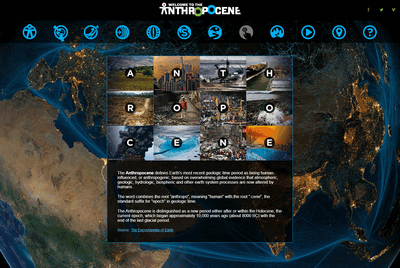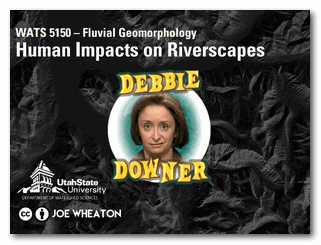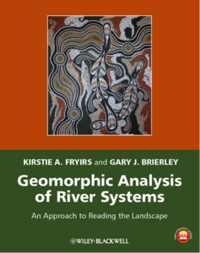Background and why we're covering it
 Although we have spent the majority of this class focusing on an understanding of fluvial geomorphology under natural conditions, we now live in the Anthropocene. Virtually all of the geologic, climatic, hydrologic, ecologic and ultimately geomorphic processes we covered this semester can be influenced by humans. These influences do not invalidate anything we have studied this semester, they simply complicate the context and causality. The same tools you have developed this semester for reading riverscapes still apply. However, you may need to exercise caution in what can be attributed to natural processes alone, or might need sole or shared attribution to anthropogenic activities and influences. This chapter unpacks some of our most common influences and impacts.
Although we have spent the majority of this class focusing on an understanding of fluvial geomorphology under natural conditions, we now live in the Anthropocene. Virtually all of the geologic, climatic, hydrologic, ecologic and ultimately geomorphic processes we covered this semester can be influenced by humans. These influences do not invalidate anything we have studied this semester, they simply complicate the context and causality. The same tools you have developed this semester for reading riverscapes still apply. However, you may need to exercise caution in what can be attributed to natural processes alone, or might need sole or shared attribution to anthropogenic activities and influences. This chapter unpacks some of our most common influences and impacts.
Learning Outcomes
- LO 8. Understand human impacts on riverscapes and fluvial forces.
Resources
No video lecture was assigned for this module. The slides below were used and referenced in an in-class lecture and discussion.
Slides
Slides

Lecture Slides - Module 13
Human Impacts on River Systems
Other Resources
Corresponding Chapter in Course Text
 From:
Fryirs KA, Brierley GA. 2013. Geomorphic Analysis of River Systems: An Approach to Reading the Landscape, First Edition. Blackwell Publishing Ltd.: Chichester, U.K.
From:
Fryirs KA, Brierley GA. 2013. Geomorphic Analysis of River Systems: An Approach to Reading the Landscape, First Edition. Blackwell Publishing Ltd.: Chichester, U.K.
This module focuses on: CHAPTER THIRTEEN: Human impacts on river systems
Other Courses
The focus of this introductory fluvial geomorphology class was not on human impacts to river systems. A number of other courses at USU focus on some of these impacts as well as conservation and restoration actions we can take to mitigate, reverse and address such impacts. A partial list of some of those in WATS is shown below:
Impacts
- WATS 5330/6330 - Large River Management
- WATS 6050 - Aquatic Ecosystems and Water Resources Systems Modeling
Restoration and Conservation
- WATS 5310 - Ecology and Restoration of Weltand and Riparian Plants
- WATS 5340 & 5350 - Management and Restoration of Aquatic Ecosystems Capstone I & II
- WATS 6700 - Restoration Ecology
- WATS 6750 - Prioritzing Conservation and Management Actions with Marxan
- WATS 5620-5624 - Low-Tech Process-Based Restoration of Riverscapes
Relevant or Cited Literature
Follow up selected readings suggested by Fryris and Brierley (2013) are provided for every chapter in page 328-334 of the text book.